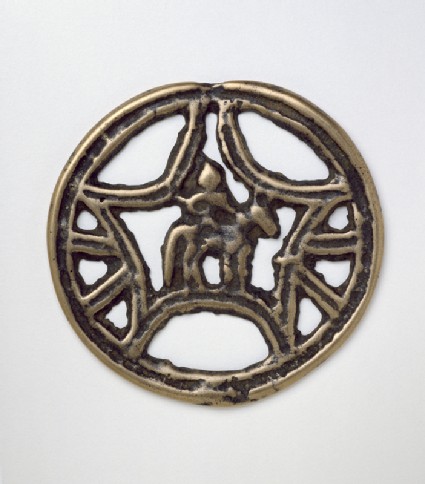Browse: 1 object
- Reference URL
Actions
Talismanic plaque, or tokcha, with horse and rider
-
Details
- Associated place
- Date
- 9th century AD (AD 801 - 900)
- Material and technique
- brass
- Dimensions
-
0.2 cm (height)
7.3 cm (diameter)
- Material index
-
processed material › metal › alloy › copper alloy › brass
- Technique index
- Object type index
- No. of items
- 1
- Credit line
- Purchased, 2000.
- Accession no.
- EA2000.109
-
Further reading
Heller, Amy, Early Himalayan Art (Oxford: Ashmolean Museum, 2008), no. 34 on p. 112, illus. p. 113
Location
Objects are sometimes moved to a different location. Our object location data is usually updated on a monthly basis. Contact the Jameel Study Centre if you are planning to visit the museum to see a particular object on display, or would like to arrange an appointment to see an object in our reserve collections.
Galleries
Publications online
-

Early Himalayan Art
The horse and rider are represented within the central interstice between five confronting arcs, two of which are subdivided into smaller segments. It is likely that strands of leather or thread would have been passed through the openings behind the arcs and fastened in place by looping through the smaller apertures. The dimensions of this plaque suggest that it could have been employed in horse trappings. The rider is delineated by a three-quarter view of his head and shoulders. His right arm is extended toward the horse's mane, appearing to hold the reins, while the left arm rests at his left hip. Behind the left arm a quiver or bow-case may appear, as the point of either a bow or arrow is seen. Two other horse and rider amulets have been documented, but neither shows any weapons or armour [1]. In portraits of protector deities, bows and arrows in holders on their backs are often shown, as in this example. The horse itself is also in silhouette, but the four legs are visible, very thinly modelled. The tail is very long, a realistic feature of Tibetan horses, which are small and compact with a heavy mane and tail. The rider appears to be wearing a pointed helmet. Such armour could possibly be Tibetan or Central Asian. Central Asian helmets of the rulers of Sasanian Iran and Sogdiana, as represented in coins and mural paintings, have elaborate sun-moon finials, but the normal cavaliers' helmets, as excavated in Iran, are similarly shaped with a low point, as with the rider on this tokcha [2]. Excavations from central Tibet have revealed a low helmet finial in beaten gold, and similar low-pointed helmets are found in the earliest representations of Tibetan warriors wearing armour, painted on wood panels excavated from a late eighth- to early ninth-century Tibetan tomb in what is now Qinghai province [3]. Thus it is quite possible that this represents a Tibetan rider on horseback. In view of the great importance of the horse, a guide for the deceased in the after-life according to the pre-Buddhist Tibetan liturgy of funeral ceremonies [4], a horse trapping such as this would be appropriate as a protective amulet for a horse or, possibly, even for the rider, if attached to his garments.
[Footnotes:]
1 See Anninos, 'Tokches: Images of Change in Early Buddhist Art', pls. 16-17.
2 Van den Berghe and Overlaet, Splendeurs des Sassanides, pls. 33-4, for excavated examples attributed to 6th-7th-century Iran.
3 For a photograph of the gold finial, see Kaogu, no. 6, 2001, pl. 6, referring to the article on the excavation of a tomb at Chijiagou in Nagarze, Tibet, by Shannan Bureau of Cultural Relics: Kaogu 6, 2001, pp. 45-8; for the painted panels from the tomb, see Xu Xinguo, Cultural Relics World (Wen Wu Tian Di), vol. 3, 2004, pp. 17-21.
4 See cat. 28 above (tokcha with confronted horses).
© 2013 University of Oxford - Ashmolean Museum




